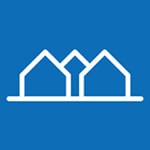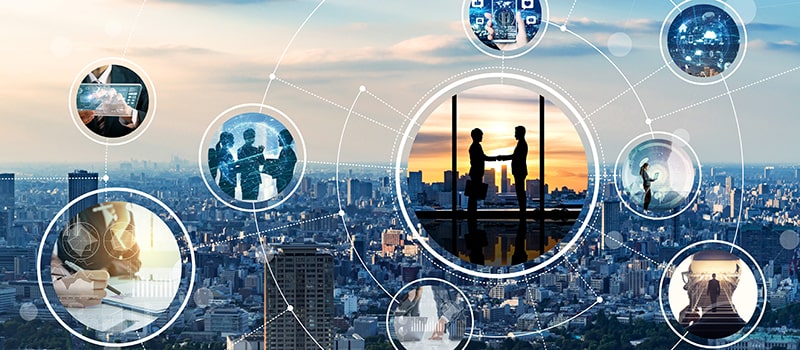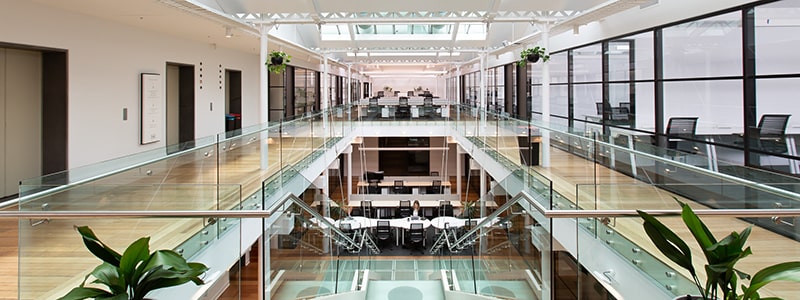The changing nature of work is driving the transformation of workspaces, from the place where assigned tasks were completed under direct supervision to intentional spaces where collaboration and engagement drive innovation and productivity. Digital transformation affords more possibilities than were available to previous generations, and yet as organizations endeavor to encourage collaboration, improve engagement, and retain top talent, they may find the answer lies not in another app, but in their physical space.
Rethinking Office Spaces for Today’s Workforce
Gone are the days of show up, get work done, go home, repeat. Today, work is flexible and collaborative and increasingly creative. Consider trends like remote work, video conferencing, cloud computing, and other innovative disruptions affecting physical spaces. Organizations are moving away from traditional office environments and toward spaces that mirror how we really work and live.
“It's not about having people in the office, it's now about having people interacting in different ways, depending on the type of work that they're doing.”
“The big question is how do people work and how do they interact with each other,” according to Carolyn Trickett, head of business technology, property and asset management at global real estate services firm JLL, and speaker at the AESC APAC Conference 2019. “Workspaces aren’t about a cubicle farm full of desks with people beavering away on their computers anymore.” She says, “It’s not about having people in the office, it’s now about having people interacting in different ways, depending on the type of work that they’re doing.”
Maja Paleka, a founder and director of Juggle Strategies and an expert in flexible work practices, advises clients to be deliberate about how a workspace will serve their organization. The ideal, according to Paleka, is “to create a place that is purpose-designed, where people are very careful and purposeful about how this space is going to serve us, what it is going to deliver, and what it is designed for.” She says, “Sometimes where organizations fumble is when the initial motivation is about cost-cutting, real estate consolidation and things like that. So if you go at it from that perspective, you won’t always necessarily get the right outcome.”
Courtney Cotrupe is president of Partners + Napier, a creative agency that recently completed the build-out of a new space. Thinking about how people work today, she says the new space was inspired by the concept of “resimercial.”
“Think about how you work at home: you might wake up in the morning, grab a cup of coffee, start to do some emails in the kitchen, then maybe you grab your laptop and go to the dining room table, and maybe you get up and walk around while you have a conference call. We really wanted to inspire that type of work, here,” Cotrupe says.
According to Christhina Candido, PhD at The University of Sydney, “People are starting to realize that we need to be provided with different types of infrastructure, different spaces within the same open office plan to actually do all of our activities, because we don’t do the same thing during the whole day. There are parts of our day that we need to go to a space to concentrate, there are parts of the day where you actually are happy to hang out with colleagues. And there are times that you actually need to have a moment to yourself.”
For instance, Brad Krauskopf, CEO and Founder of Hub Australia, the country’s largest owned and operated co-working provider, says of the spaces Hub provides, “If people want to work in their office with the rest of their teammates, at a normal sized desk, or in a really comfy office chair, they can do that. And if they want to work at a standup desk in a breakout lounge environment in a café, in a kitchen, in an active brainstorming room, or standup meeting space, all of those things are possible.”
Sharon Napier, CEO of Partners + Napier adds, “We’re in the service business, and it’s a really high stress business. But on a Sunday night when you’re doing some work, and you make yourself a cup of tea or pour yourself a glass of wine, it’s a lot nicer, right? That anxiety just goes down. So the whole idea of our space is easing the tension between high pressure and ambition, and a finding way of working that is just so respectful.”
Evolving Environments
What do these emerging environments look like? The common feature is flexibility, and the spaces themselves take several forms.
 The Open Office
The Open Office
With growing recognition that hierarchies and siloed thinking inhibit innovation and agility, flatter organizations are leading the departure from private offices in favor of open workspaces. Rowland Hills, chief operating officer at Leathwaite says, “I think there’s a lot to be said for having the much less hierarchical approach that you get from more of an open plan office, where the bosses sit with everybody they’re working with, where project teams can just turn around and have quick conversations, where it’s easy to pick up on something that’s happening on the other side of the office and join in, if it’s relevant for you to contribute. And I think those are all good things about the open office,” Hills says.
 Neighborhoods
Neighborhoods
In 2016 Microsoft redesigned a part of its campus into neighborhoods. Jennifer Warnick wrote for Microsoft Story Labs, “For decades, Buildings 16 and 17 consisted largely of private offices, but with the remodel, the walls literally came tumbling down. Now, everyone works in a neighborhood. Essentially, it’s like the student housing at the fictional Hogwarts—each team works from its own large, open common room, one they were invited to customize to their liking. Each team also has dedicated focus and meeting rooms.”
While many companies have open office plans with neighborhood zones designated by discipline, for example writers all seated together, Partners + Napier structures their neighborhoods around client industries. For example, people who serve clients in the food and beverage industry work in the same space. “Our neighborhoods create brain trusts, a mixture of account, creative, and planners who have the same area of expertise,” Partners + Napier founder and CEO Sharon Napier explains. “Neighborhoods allow us to bring people together so that collaboration happens more naturally.”
 Activity-based working
Activity-based working
Activity-based working is the concept of employees choosing from among a variety of different workspaces that best support the type of work they are doing on any given day. “It has been really big in the Netherlands where it originated. It’s really quite big in Australia, and I think the US market is now starting to get into this concept,” according to James Dellow, director at Digital Workplace Company. “It’s not just open plan, but very carefully designed workplaces where you have a variety of different spaces.”
For example, Cotrupe says, “For every person, there are actually three places in the building where that person could sit. And a very important part of how the entire space was designed led to the gathering spaces for where we come together as an organization, how people feel at their desks, and the communities we created around our clients so that we’re always thinking about their business.”
 Co-Working
Co-Working
Co-working is the concept of the shared workspace, for example WeWork, and Hub Australia. Krauskopf says, “When co-working first got its real kick after the global financial crisis, the single biggest reason you would get co-working around the world, not just at Hub, was escaping the isolation, the loneliness of working at home.”
Now, according to Trickett, co-working is a significant trend in the real estate industry. “I think that’s evolved over the last few years to not just be about somebody booking a desk in a shared coworking office. It’s also about creating more public places where people can go and interact, and having that integration between the office type of workspace, with the open community workspace.”
“We’re seeing that a lot more, where you used to have an office where the lobby was just some gaping hall, echoey and bland, but now it’s a community engagement space. And that’s one of the biggest trends we’re seeing in terms of common space usage,” Trickett says.
 Hot Desks & Hoteling
Hot Desks & Hoteling
Hills describes an environment where people work where they want, without an assigned desk. “What we’re seeing now in office design is something that’s much more functionally based and which has much more of a flat structure to the interior design to mirror, to some extent, flatness in organizational design. I’ve seen a number of offices of professional service companies where the partners in the companies sit in exactly the same desks as everyone else, and in fact, several organizations where people hot desks completely and the managing partner comes in the morning and puts their laptop down on any desk that happens to be free and sits beside different people everyday.”
There remain arguments for providing workers with private offices. For example, Human Spaces found “Globally, our research has shown that workers’ productivity depends upon the environment they are in. 39% of workers felt most productive at their own desk in a private office. The countries with the greatest preference for a private office were Germany (59%), China (52%), Canada (50%), Sweden (49%), the US (45%), Denmark (44%), France (43%) and the Netherlands (41%). 36% felt most productive at their own desk in an open plan environment.”
What most of the open plan scenarios above argue for is a flexible design that offers employees a variety of environments in which to work, including quiet spaces, and grants them the freedom to choose where to work, when.
The new workspaces, however, must be designed to integrate technology. Dellow explains, “The designers were seeing that things weren’t quite working as they wanted, or it dawned on them as they’re working through these projects that they could no longer just ignore the technology aspect.”
Tech at Work
Embedding technology into an evolving workspace needs fresh thinking, not just moving the same content and same processes to digital. Trickett warns, “When you’re digitizing, the human tendency is to try to recreate exactly what you’re doing now, but just online. It’s a very special skillset to find somebody who can look at digitizing a process and improving that process at the same time.”
For example, Dellow points out the error in “the old school teleconference rooms that have been retrofitted for video conference.” He says, “I’ve seen some terrible examples where you have a very long room, and for a video conference with a single camera, that’s just a really poor working environment. That’s not going to enable you to transform, to make the big shift towards small-team collaboration.”
“Digital transformation is certainly about the technology, but it’s also about having a place where you have the right space that you give to people in order to drive that transformation,” he says.
For Paleka, one of the greatest benefits of tech in the workplace is connecting people across distances. “Some of our clients are doing wonderful things, for example software development teams who are including remote workers in standups. They were struggling with ‘how do we get people who work from home or work remotely, to do a standup?’ So they put cameras in areas of their business where people can have a huddle. So, the technology is not the problem, and the clever ones are actually finding lots of options out there.”
Much about how people live is influencing how they want to work, Hills observes that “a lot of tools are coming into our personal lives first, before they start to get into the workplace.” For example, he says, “Take video conferencing. People have been using FaceTime and Skype at home for ages, and they’ve been quite happy to call their grandmother on them and whoever else. Video conferencing is becoming easier to use, and that’s being driven by the consumer versions of things, not the business version of things.”
“Digital transformation is certainly about the technology, but it's also about having a place where you have the right space that you give to people in order to drive that transformation,”
That trend, Hills says, influences employee expectations. “We’re hiring people who are surprised if they don’t get flexible working technology, if they don’t get the ability to do things where they want. They have grown up with a laptop or tablet and they are used to doing things where they want, and they want that in their professional world as well. I think a lot of these things are going to come from the non-work environment into the work environment, and as people start to do more digitally in their personal lives, they will expect to be able to do more digitally in their work lives, too.”
With the accelerating pace of change, particularly technology, construction can’t keep up. Trickett explains, “One of the challenges that we face in the construction side of the industry is that technology is now moving so fast that you can design a building with all the latest technology, but then buildings take a long time to build, and by the time they’re built, they’re not the latest technology anymore. It’s hard for them to keep up. So when you’re talking about workspaces, I think technology itself is not the driver. What you need to think about when you’re redesigning a workspace is how people will interact with the technology.”
Technology in the office is not just in the devices employees use to analyze, communicate, or create. It’s in the very walls. “The emergence of cloud computing means that IT is taking on a bigger role in some of those embedded pieces of technology you’d see in the modern office, for example meeting rooms with teleconferencing systems,” Dellow says. “But there’s a whole massive technology layer in buildings themselves now. There’s almost a digitization of the physical space at work, as well.”
For Paleka, “Technology is wonderful and we see organizations across the world take the time to really learn to use the technology and build relationships and human connections across the world through tech, whether it’s Slack or video conferencing or any other technologies that are there. But they still recognize that having a space that people come to, where they can still collaborate, that is important, so that’s where I think ultimately we want to get to.”
Impact and Outcomes
These intentional, flexible, digitized workspaces are affecting innovation, collaboration, company culture, employee engagement and retention, and even sustainability.
Innovation may be one of the benefits of coworking. According to Krauskopf, “When you have that diversity of industries, businesses, and age groups, that means that there’s a great deal of opportunity for innovation. It’s well-understood that bringing diverse people, ways of doing business, and ideas together is key to innovation.”
According to the U.K. Workplace Survey 2019 by Gensler Research Institute, a global interior design firm, there is a correlation between innovative organizations and flexible work. “Not only variety but the freedom to work wherever and whenever is most effective, is a key performance driver for UK workers and workers across the world. Employees who rate their organizations highly on innovation measures also report having greater choice and use a wider range of workspaces to get their work done.”
“Employees who rate their organizations highly on innovation measures also report having greater choice and use a wider range of workspaces to get their work done.”
A key driver of innovation is also collaboration, which is vastly improved by the technology available in the updated workplace. Trickett recalls, “Once upon a time, on a conference call we had no idea where people were, whether they were even listening. You’d get the old, ‘Sorry, I didn’t catch that, can you repeat the question please? Because that person was actually working on something else.’” But now, she says, “We see people’s faces on the screen and we’re sharing documents and white boarding, so that we can be talking through points and drawing diagrams and that’s had an incredible effect on people’s ability to work from different locations but all focus on the same task.”
A surprising benefit of good office design is employee engagement and retention.
According to the Steelcase (a leading office furniture manufacturer) 2016 Global Report, Engagement and the Global Workforce, “The most highly engaged employees have greater flexibility to make choices about where and how they work. They can move around the office easily, change postures and choose where they want to work in the office based on the tasks they need to do.”
For Krauskopf, “The single biggest reason that one of our members will give us as to why they grow their business with Hub Australia is their ability to attract and retain staff.” He explains, “The companies that work from the Hub, when they’re in their own war for talent, they’re saying come and work for our growing business, get the authenticity, get the autonomy of working as part of a smaller, growing team with a great culture, but don’t give up on any of the perks of the corporate office. And more importantly, you’re part of something bigger.”
A full third of respondents in a global survey said the actual workspace would weigh into their choice of employer. According to the Human Spaces research report The Global Impact of Biophilic Design in the Workplace, “Many respondents, a third (33%) in fact, reported that they would be affected by workplace design when choosing to work for a company. This emphasizes how an individual’s surrounding environment can directly influence how they feel about the organization, which will inevitably influence their feelings and behaviors when they are working. Therefore, providing workers with an environment that they are comfortable and happy within is likely to go a long way in increasing well-being and productivity, as well as contributing to the retention of staff and reducing employee turnover.”
Can a space also influence corporate culture? Research suggests it can. For example, flexible workspaces give employees the opportunity to balance both solo and group work. According to the Gensler Research Institute Asia Workplace Survey 2016, “Employees in balanced workplaces see their managers in a more positive light, are able to communicate more openly and honestly, better receive feedback, and reported higher work-life balance and job satisfaction. The quality of relationships is also a key factor in creating a culture of creativity and innovation at work.”
For Dellow, all-hands sessions, live or digital, serve as important cultural glue. “One of the trends I’m seeing is spaces where you have some sort of tiered seating or steps that can be used for town halls. And equally, I’ve been working with organizations using solutions like Yammer and Workplace by Facebook, et cetera. And one of the big things they want on the technology side is the ability to stream those all-hands presentations from the CEO. With people, it’s really critical that they have the ability to have the leader of the organization talk directly to everyone. And I can see those parallels in the physical space and the digital space.”
Napier agrees. “Gathering together in a central place and being able to come together as one agency was really important, so important that we decided to cut a hole in the floor and make a whole signature staircase. It’s a place where everyone can gather, we’ve got the projector, we have multiple sightlines, and it’s just a really beautiful spot to get together. We do all organization meetings gathered together on the stairs. It’s white oak, a hundred year old wood that was reclaimed from a barn in the southern tier.”
33% reported that they would be affected by workplace design when choosing to work for a company.
Reclaimed wood, live plants, natural textures and hues are increasingly important in workspaces. Paleka says, “Because there is so much of that integration of work and life, we’re seeing more organizations create these really comfortable spaces, so huge use of natural materials is a trend, seeing lots of greenery, but again, creating purposeful spaces within them.”
A larger purpose for Krauskopf is sustainability. He explains, “When people are working this much and you’ve got the war for talent, people want to make sure that they’re working with an employer and working at a workspace that cares about more than just a bottom line.” For instance, Hub Australia is one of the founding B Corps in Australia; B Corps are certified as to their impact on their workers, customers, suppliers, community, and the environment. “We get audited every couple of years across a huge range of different environmental, social, community, and governance aspects. That’s been a huge attractor of our team, and it keeps people here, not to mention the impact that it has on the planet.”
Technology has enabled important sustainable practices. For example, Trickett says, “A really simple example is having lights in your fire escape stairwells, that only switch on when somebody is in the stairwell. Some of our clients have saved hundreds of thousands of dollars (and a lot of energy) just by implementing that. They’re not using electricity when there’s no one in the stairwell.”
For Hills, responsibility is as important as sustainability. “How do you make sure that as a company, if people are working in other places, you’re still providing them with what they need?” For example, “As people work from home, as people work from other locations, is there a duty of care? A responsibility you have for them? That’s something every company is going to have a different answer to. Because when people can work from anywhere, how do you ensure that they’re working safely, working productively? Just because someone can work anywhere, if they don’t have a desk to work at, they don’t have a chair, they don’t have good lighting, then is that the right thing for them to be doing?”
The Workspace of the Future
We can safely anticipate a lot of change in our physical workspaces, from the people engaged there to the tools that we use.
The workspace of the future is intergenerational.
“At the moment, millennials are about to start turning 40, so, they’re not too young anymore,” Klauskopf says. “As we go on and the retirement age extends out, with the flexibility that’s offered by freelance work, I think we’re going to also see that the work environment has a huge number of people in their 60s, 70s, and 80s.”
And different generations have different expectations that competitive workplaces will have to meet. For example, Candido says, “According to recent reports, the millennial working force expect to have a better life-work balance with some even trading a lower pay in exchange for more leave days, to actually enjoy life a little bit more. And of course, the whole idea that the top dog gets the corner office does not apply anymore—where you sit in an office no longer defines your stature in the organization.”
In Hills’ experience, “Young people in particular are expecting a lot more flexibility. They don’t want to be at their desks all the time, they want to be doing different things, they want to be able to work from home and they want to be able to move around—they want to stand up sometimes when they work rather than sit down, and I think being able to support the different ways people want to work is quite important.”
Candido agrees. “It’s quite an interesting mix, and exciting from the research perspective, and quite challenging for those who are actually managing corporate real estate, and especially the workplace experience. So I think the role of workplace experience managers are just becoming more and more important,” she says.
The workspace of the future is digital.
Technology already provides advanced communication tools connecting workspaces to clients and collaborators worldwide. What’s next?
For Krauskopf, “Virtual reality is finally going to make remote work truly a norm, because it will reduce greatly the sense of isolation that you still get from being a remote worker. Stay tuned to see what happens with virtual reality,” he says.
It’s not so far away. Dellow explains, “They are able to make digital twins, more in the case of infrastructure, and have a virtual digital twin of the building which you can kind of look at, interrogate, and monitor.” He also imagines “our own personal digital twin, who is going to be the sort of concierge force of a digital system,” who can, for example, “tell us your project team is currently working from the cafe at Central Park today, and it will take you 10 minutes to get there.”
Making the Transition
Whatever office design an organization chooses (or creates), transforming a workspace begins well before the architects and designers start their drawings. Trickett describes, “First, an analysis phase of what people are doing, how long they spend doing it, and where they like to do it, or what would be the best type of space to be doing that work in.”
For Candido, “It really needs a hands on process where voices are heard, and people have an opportunity to influence and shape this space, in the way they see the business going forward. There is a missed opportunity when the design is not really user-centric. It needs to be an authentic process, and I think that’s when people get it wrong.”
Long before Partners + Napier took down the first wall in their new space, they engaged the whole office. “Before we built the space, our Chief Creative Officer who led the design met with different groups to understand their needs,” Napier says. “A lot of people were worried about moving into neighborhoods and having account people sitting next to creative people, for example, so for months employees could put in their concerns and we could answer all their questions. Sometimes the questions were ‘are we going to have nap desks?’ and we would just answer with a sense of humor: ‘no, it’s still work, guys!’”
For Candido, the new approach to office space has tremendous potential for positive change. “The whole adaptation of the office to what people do during the day is a game changer. Because it gives you first of all, freedom. If you’re no longer attached to your desk, you can actually find suitable spots within the same open plan office that are more suitable to your needs. That’s one of the key findings of my research. And the final one is, I think we’ll see more heavy emphasis on the design of these spaces, with requirements like access to daylight, access to an outdoor environment and integration with nature, biophilic design aspects, etcetera. It’s not a trend, it’s here to stay. And that has a positive impact on people’s perception of their space.”
Candido is surprised by what she is finding in her research. “I’m actually really surprised about how much we can change people’s satisfaction, or help people, the workforce, by just being true to the design of their space. That really surprised me in a good way, and how powerful that can be, when you combine the way of working with the office that supports that way of working. I found that it was quite surprising, magical, to the point that I’m just spending a couple of years doing research on that. Because I’m fascinated by it.”
With only a few months in, it’s early days at Partners + Napier for metrics and analysis on the benefits of the new space, but Cotrupe has heard firsthand accounts: “People recite it back to us, ‘I stood up a little taller, I walked a little faster.’ They’re more engaged than I think I ever thought they would be and it’s because the environment is inspiring them to be that way. So it’s really incredible the difference a space can make in your mental approach to work everyday.”
Paleka says, “Future work trends and where organizations are going—this is not just a nice thing we should do for our people, it actually, genuinely makes sense in terms of productivity, in terms of revenue impact, in terms of cost, and everything else. Let’s move the perspective over, and think about what this is going to do for your business.”
Can organizations ignore the call to rethink their spaces? Probably not. Krauskopf says, “I think what we’re seeing is a fundamental shift, where, because technology allows people to work anywhere, people are going to have to have more and more really great reasons to come into work each day.”
Receive AESC's Executive Talent Monthly - Insights for the C-Suite




